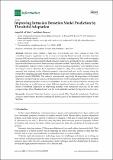Files in this item
Improving intrusion detection model prediction by threshold adaptation
Item metadata
| dc.contributor.author | Al Tobi, Amjad Mohamed Hamdan | |
| dc.contributor.author | Duncan, Ishbel Mary Macdonald | |
| dc.date.accessioned | 2019-05-02T12:30:01Z | |
| dc.date.available | 2019-05-02T12:30:01Z | |
| dc.date.issued | 2019-04-30 | |
| dc.identifier | 258834046 | |
| dc.identifier | a62db5d7-00dc-4312-a222-1f3fec02a408 | |
| dc.identifier | 85065886636 | |
| dc.identifier | 000470959300006 | |
| dc.identifier.citation | Al Tobi , A M H & Duncan , I M M 2019 , ' Improving intrusion detection model prediction by threshold adaptation ' , Information , vol. 10 , no. 5 , 159 , pp. 1-42 . https://doi.org/10.3390/info10050159 | en |
| dc.identifier.issn | 2078-2489 | |
| dc.identifier.other | ORCID: /0000-0001-7297-9199/work/57088496 | |
| dc.identifier.uri | https://hdl.handle.net/10023/17630 | |
| dc.description | This research was supported and funded by the Government of the Sultanate of Oman represented by the Ministry of Higher Education and the Sultan Qaboos University. | en |
| dc.description.abstract | Network traffic exhibits a high level of variability over short periods of time. This variability impacts negatively on the accuracy of anomaly-based network intrusion detection systems (IDS) that are built using predictive models in a batch learning setup. This work investigates how adapting the discriminating threshold of model predictions, specifically to the evaluated traffic, improves the detection rates of these intrusion detection models. Specifically, this research studied the adaptability features of three well known machine learning algorithms: C5.0, Random Forest and Support Vector Machine. Each algorithm’s ability to adapt their prediction thresholds was assessed and analysed under different scenarios that simulated real world settings using the prospective sampling approach. Multiple IDS datasets were used for the analysis, including a newly generated dataset (STA2018). This research demonstrated empirically the importance of threshold adaptation in improving the accuracy of detection models when training and evaluation traffic have different statistical properties. Tests were undertaken to analyse the effects of feature selection and data balancing on model accuracy when different significant features in traffic were used. The effects of threshold adaptation on improving accuracy were statistically analysed. Of the three compared algorithms, Random Forest was the most adaptable and had the highest detection rates. | |
| dc.format.extent | 42 | |
| dc.format.extent | 3189583 | |
| dc.language.iso | eng | |
| dc.relation.ispartof | Information | en |
| dc.subject | Intrusion Detection System | en |
| dc.subject | Anomaly-based IDS | en |
| dc.subject | Threshold adaptation | en |
| dc.subject | Prediction accuracy improvement | en |
| dc.subject | Machine learning | en |
| dc.subject | STA2018 dataset | en |
| dc.subject | C5.0 | en |
| dc.subject | Random forest | en |
| dc.subject | Support vector machine | en |
| dc.subject | QA75 Electronic computers. Computer science | en |
| dc.subject | T Technology | en |
| dc.subject | Artificial Intelligence | en |
| dc.subject | Computer Science Applications | en |
| dc.subject | DAS | en |
| dc.subject | BDC | en |
| dc.subject.lcc | QA75 | en |
| dc.subject.lcc | T | en |
| dc.title | Improving intrusion detection model prediction by threshold adaptation | en |
| dc.type | Journal article | en |
| dc.contributor.institution | University of St Andrews. School of Computer Science | en |
| dc.identifier.doi | https://doi.org/10.3390/info10050159 | |
| dc.description.status | Peer reviewed | en |
| dc.identifier.url | https://www.mdpi.com/journal/information/special_issues/ML_Cybersecurity | en |
This item appears in the following Collection(s)
Items in the St Andrews Research Repository are protected by copyright, with all rights reserved, unless otherwise indicated.

